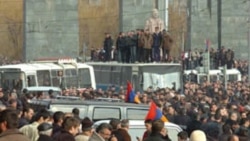By Emil Danielyan and Karine Kalantarian
In a newspaper interview published on Friday, President Serzh Sarkisian defended the Armenian authorities’ use of lethal force against opposition protesters challenging his disputed election victory, saying that it helped to save many other lives. “Failure to use force would have lead to many more casualties and more severe consequences,” Sarkisian told the Russian daily “Kommersant,” commenting on the March 1 clashes in Yerevan between security forces and supporters of his main election challenger, Levon Ter-Petrosian.
“Force was used not against the protesters but those who looted shops, shot at the police and hurled grenades at policemen and interior troops,” he said. “How should we have reacted? There was no gunfire directed at the protesters, gunfire occurred one kilometer away from them.
“It is the protesters who used force against the police that tried to maintain public order.”
The unprecedented violence, which left at least ten people dead, followed the dispersal earlier on March 1 of Ter-Petrosian’s non-stop peaceful protest in Yerevan’s Liberty Square. Thousands of angry supporters of the opposition leader gathered and barricaded themselves in an area near the Yerevan mayor’s office hours later.
Eyewitnesses, among them an RFE/RL correspondent, say that without prior warnings, security forces fired tracer bullets over the crowd for more than 40 minutes in a bid to disperse it. In the meantime, a unit of riot troops charged towards one of the barricades but fled the scene after unsuccessful pitched battles with opposition supporters armed with sticks, stones and Molotov cocktails.
At least eight civilians and two interior troops were killed on the spot and hundreds of meters away from it in circumstances that remain unclear. The crowd left the barricaded area in the early hours of March 2 after a telephone appeal from Ter-Petrosian, who cited the declaration of a 20-day state of emergency by outgoing President Robert Kocharian.
The Armenian authorities say the clashes were instigated by Ter-Petrosian with the aim of staging a coup d’etat. Ter-Petrosian and his opposition allies strongly deny this, saying that the government resorted to the “slaughter” to end peaceful street protests against official results of the February 19 presidential election.
The official theory has also been questioned by Armenia’s human rights ombudsman and Western governments and human rights organizations. The latter have called for an independent inquiry into the unrest.
Asked by “Kommersant” whether all eight civilian victims were looters, Sarkisian said: “That is not a fact. The fact is that all ten persons died one kilometer away from the [municipality] square. The [official] investigation is continuing and I think it will clear up everything.”
Echoing statements by Armenian law-enforcement officials, Sarkisian added that three of the victims died as a result of unspecified “special means” used by the riot police. “Those were either old special means or were used wrongly,” he said. “The investigation will bring clarity.”
One of the officials leading the inquiry, Vahagn Harutiunian, told RFE/RL on Thursday that the investigators have still not identified the security officers who “deliberately, accidentally or legitimately caused those deaths.” “But we have been working in that direction from the first day of the investigation,” he said.
Harutiunian also said that the investigators have yet to clarify who and how killed the five other protesters. “The investigating body has clarified the places where those persons were killed and the nature of their injuries,” he said. “Right now we are investigating the circumstances in which they suffered the injuries.”
More than 100 opposition members and supporters were arrested following the unrest. None of them was charged in connection with the March 1 deaths of the two interior troop servicemen.
(Photolur photo)




